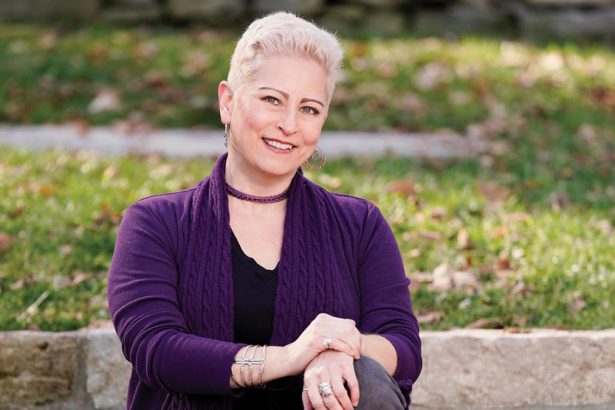Patient Search
 |
 |
|
KaCrole Higgins was diagnosed with breast cancer in 2020. “In May 2020, I found a lump in my breast. I cried. By June, it was diagnosed as breast cancer, triple positive, stage 1A. While getting this cancer diagnosis was devastating, it also became an opportunity. Suddenly, the cancer gave me clarity. It gave me clarity about what was important, what was good in my life, what was toxic in my life, and what I needed to do.” Click below to read more of KaCrole’s story |
If Landon Ryan had been diagnosed with bilateral retinoblastoma 10, 20 or 30 years ago, she might not be here today with nearly perfect vision.Thanks to recent improvements in the treatment for this rare form of cancer that almost exclusively affects children under the age of 5, the diagnosis had the power to change Landon’s life when she was 11 months old, but not to take it — or her eyesight. Click below to learn more about Landon and her story. https://momentum.vicc.org/2022/04/brighter-outlook/ |
Testing Atezolizumab Alone or Atezolizumab Plus Bevacizumab in People with Advanced Alveolar Soft Part Sarcoma
Sarcoma
Sarcoma
This phase II trial studies how well atezolizumab or atezolizumab plus bevacizumab works in treating patients with alveolar soft part sarcoma that has not been treated, has spread from where it started to other places in the body (advanced) and cannot be removed by surgery (unresectable). Atezolizumab works by unblocking the immune system, allowing the immune system cells to recognize and then attack tumor cells. Bevacizumab works by controlling the growth of new blood vessels. Giving atezolizumab alone or atezolizumab with bevacizumab may shrink the cancer.
Sarcoma
II
Davis, Elizabeth
NCT03141684
VICCSAR16155ET-CT
HLA-Mismatched Unrelated Donor Hematopoietic Cell Transplantation With Post-Transplantation Cyclophosphamide
Multiple Cancer Types
This is a prospective, multi-center, Phase II study of hematopoietic cell transplantation
(HCT) using human leukocyte antigen (HLA)-mismatched unrelated donors (MMUD) for peripheral
blood stem cell transplant in adults and bone marrow stem cell transplant in children.
Post-transplant cyclophosphamide (PTCy), tacrolimus and mycophenolate mofetil (MMF) will be
used for for graft versus host disease (GVHD) prophylaxis. This trial will study how well
this treatment works in patients with hematologic malignancies.
(HCT) using human leukocyte antigen (HLA)-mismatched unrelated donors (MMUD) for peripheral
blood stem cell transplant in adults and bone marrow stem cell transplant in children.
Post-transplant cyclophosphamide (PTCy), tacrolimus and mycophenolate mofetil (MMF) will be
used for for graft versus host disease (GVHD) prophylaxis. This trial will study how well
this treatment works in patients with hematologic malignancies.
Hematologic,
Leukemia,
Lymphoma,
Myelodysplastic Syndrome
II
Dholaria, Bhagirathbhai
NCT04904588
VICCCTT2171
Acalabrutinib for the Treatment of Chronic Graft Versus Host Disease
Miscellaneous
Miscellaneous
This phase II trial studies how well acalabrutinib works in treating patients with chronic graft versus host disease. Acalabrutinib may be an effective treatment for graft-versus-host disease caused by a stem cell transplant.
Miscellaneous
II
Kitko, Carrie
NCT04198922
VICCCTT2122
A Study of LSTA1 When Added to Standard of Care Versus Standard of Care Alone in Patients With Advanced Solid Tumors
Multiple Cancer Types
The goal of this clinical trial is to test a new drug plus standard treatment compared with
standard treatment alone in patients with advanced head and neck squamous cell carcinoma and
cholangiocarcinoma.
The main questions it aims to answer are:
- is the new drug plus standard treatment safe and tolerable
- is the new drug plus standard treatment more effective than standard treatment
standard treatment alone in patients with advanced head and neck squamous cell carcinoma and
cholangiocarcinoma.
The main questions it aims to answer are:
- is the new drug plus standard treatment safe and tolerable
- is the new drug plus standard treatment more effective than standard treatment
Gastrointestinal,
Head/Neck
II
Heumann, Thatcher
NCT05712356
VICC-DTMDT23185
Avelumab or Hydroxychloroquine with or without Palbociclib for the Treatment of Stage II-III Breast Cancer, PALAVY Study
Breast
Breast
This phase II trial investigates the effect of avelumab or hydroxychloroquine sulfate with or without palbociclib in treating patients with stage II-III breast cancer that is positive for disseminated tumor cells (DTCs) after curative therapy. DTCs are breast cancer cells that are asleep (dormant) in the bone marrow. There are multiple ways in which these cells stay alive, and three of these mechanisms are inhibited by the drugs in this trial. First, dormant cancer cells need a protein signal pathway involving CDK 4/6 to start dividing once they wake up in order to survive as an active cancer cell. Palbociclib works by blocking the CDK 4/6 protein and by doing so may limit the dormant cancer cell from being able to survive. In addition, palbociclib may also help both of the other drugs in the trial to work better. Second, dormant cancer cells also use a process called autophagy to generate their own nutrition, which can allow them to stay asleep. Hydroxychloroquine has been shown to block autophagy, which leads to starvation of the cells. Third, dormant cancer cells are able to hide from the bodys immune system. The immune system sends a type of cell called T cells throughout the body to detect and fight infections and diseasesincluding cancers. One way the immune system controls the activity of T cells is through the PD-1/PD-L1 (programmed cell death protein-1) pathway. However, some cancer cells hide from T-cell attack by taking control of the PD-1/PD-L1 interaction and this stops T cells from attacking cancer cells. Avelumab is an antibody designed to block the PD-1/PD-L1 pathway and helps the immune system in detecting and fighting dormant cancer cells. Because palbociclib, hydroxychloroquine, and avelumab work on the mechanisms that keep the dormant cells alive, taking one or a combination of these drugs may be able to eliminate DTCs.
Breast
II
Reid, Sonya
NCT04841148
VICCBRE2161
Nivolumab and Ipilimumab for the Treatment of Patients with Locally Advanced, Metastatic, or Unresectable Liver Cancer
Liver
Liver
This phase II trial tests whether nivolumab and ipilimumab works to shrink tumors in patients with liver cancer that has spread to nearby tissue or lymph nodes (locally advanced), has spread to other places in the body (metastatic), or cannot be removed by surgery (unresectable). Immunotherapy with monoclonal antibodies, such as nivolumab and ipilimumab, may help the body's immune system attack the cancer, and may interfere with the ability of tumor cells to grow and spread. Nivolumab and ipilimumab may be effective in killing tumor cells in patients with liver cancer.
Liver
II
Heumann, Thatcher
NCT05199285
VICCGI2277
Treosulfan-Based Conditioning Regimen before a Blood or Bone Marrow Transplant for the Treatment of Bone Marrow Failure Diseases (BMT CTN 1904)
Multiple Cancer Types
This phase II trial tests whether treosulfan, fludarabine, and rabbit antithymocyte globulin (rATG) work when given before a blood or bone marrow transplant (conditioning regimen) to cause fewer complications for patients with bone marrow failure diseases. Chemotherapy drugs, such as treosulfan, work in different ways to stop the growth of tumor cells, either by killing the cells, by stopping them from dividing, or by stopping them from spreading. Fludarabine may stop the growth of cancer cells by blocking some of the enzymes needed for cell growth. rATG is used to decrease the body's immune response and may improve bone marrow function and increase blood cell counts. Adding treosulfan to a conditioning regimen with fludarabine and rATG may result in patients having less severe complications after a blood or bone marrow transplant.
Hematologic,
Pediatrics
II
Connelly, James
NCT04965597
VICCPED2192
Hormonal Therapy after Pertuzumab and Trastuzumab for the Treatment of Hormone Receptor Positive, HER2 Positive Breast Cancer, the ADEPT study
Breast
Breast
This phase II trial studies the effect of hormonal therapy given after (adjuvant) combination pertuzumab/trastuzumab in treating patients with hormone receptor positive, HER2 positive breast cancer. The drugs trastuzumab and pertuzumab are both monoclonal antibodies, which are disease-fighting proteins made by cloned immune cells. Estrogen can cause the growth of breast cancer cells. Hormonal therapy, such as letrozole, anastrozole, exemestane, and tamoxifen, block the use of estrogen by the tumor cells. Giving hormonal therapy after pertuzumab and trastuzumab may kill any remaining tumor cells in patients with breast cancer.
Breast
II
Abramson, Vandana
NCT04569747
VICCBRE2243
Testing Lutetium Lu 177 Dotatate in Patients with Somatostatin Receptor Positive Advanced Bronchial Neuroendocrine Tumors
Lung
Lung
This phase II trial studies the effect of lutetium Lu 177 dotatate compared to the usual treatment (everolimus) in treating patients with somatostatin receptor positive bronchial neuroendocrine tumors that have spread to other places in the body (advanced). Radioactive drugs, such as lutetium Lu 177 dotatate, may carry radiation directly to tumor cells and may reduce harm to normal cells. Lutetium Lu 177 dotatate may be more effective than everolimus in shrinking or stabilizing advanced bronchial neuroendocrine tumors.
Lung
II
Ramirez, Robert
NCT04665739
SWOGTHOA021901
Niraparib and Dostarlimab as Neoadjuvant Treatment for Patients with BRCA-Mutated or PALB2-Mutated Stage I-III Breast Cancer
Breast
Breast
This phase II trial studies the effects of niraparib in combination with dostarlimab prior to surgery in treating BRCA-mutated or PALB2-mutated stage I-III breast cancer. Niraparib is a PARP inhibitor, which means that it blocks an enzyme (proteins that help chemical reactions in the body occur) in cells called PARP. PARP helps repair deoxyribonucleic acid (DNA) when it becomes damaged. Blocking PARP may help keep cancer cells from repairing their damaged DNA, causing them to die. PARP inhibitors are a type of targeted therapy. Dostarlimab stimulates the immune system by blocking the PD-1 pathway. The PD-1 pathway controls the bodys natural immune response, but for some types of cancer, the immune system does not work as it should and is prevented from attacking tumors. Dostarlimab works by blocking the PD-1 pathway, which may help your immune system identify and catch tumor cells. Giving niraparib in combination with dostarlimab may work better against the tumor and maximize tumor shrinkage before surgery.
Breast
II
Abramson, Vandana
NCT04584255
VICCBRE2190



